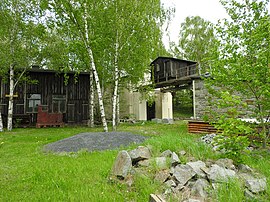Showcase and museum of the granite industry
| Showcase and museum of the granite industry | |||
|---|---|---|---|
| General information about the mine | |||
| View of the outdoor area | |||
| other names | Open-air museum of the granite industry | ||
| Mining technology | Quarry | ||
| Information about the mining company | |||
| Operating company | August Niethe | ||
| Employees | 200 (1930s) | ||
| Start of operation | 1913 | ||
| End of operation | 1971 | ||
| Funded raw materials | |||
| Degradation of | Granodiorite | ||
| Geographical location | |||
| Coordinates | 51 ° 14 '50 " N , 14 ° 0' 50.6" E | ||
|
|||
| Location | Dorfstrasse 18, Haselbachtal / Häslich | ||
| local community | Haselbachtal | ||
| District ( NUTS3 ) | Bautzen | ||
| country | Free State of Saxony | ||
| Country | Germany | ||
| District | Upper Lusatia | ||
The facilities of the open-air museum of the granite industry are located on the western outskirts of Häslich, a district of the Haselbachtal community on the site of the former company August Niethe, the former owner and operator of the “Prelle” quarry.
history
There is evidence that the development of the stone industry and the extraction and processing of West Lusatian granodiorite , which is traded as Lusatian granite , began in Häslich by the end of the 19th century at the latest . In the 19th century, the granodiorite was used to make garments, columns, troughs and rollers for the food and beverage industry. The main product was paving stones. After the Second World War , the state-owned enterprise (VEB) Granitwerk Häslich was founded, which came to VEB Lausitzer Granit in Demitz-Thumitz in the early 1970s . In addition, companies of various types of ownership continued to exist.
After the fall of the Wall , VEB Lausitzer Granit came to Basalt AG , based in Linz on the Rhine, via the Hartsteinwerke Bayern-Mitteldeutschland HBM subsidiary . This also stopped the production of ashlar at the location of the former central administration in Demitz-Thumitz, 26 km from Häslich, in 2003. The granite quarrying for gravel and gravel production has remained there.
development
The development of the promotion of natural stone in Häslich in the 19th century was shaped by the strongly increasing demand due to road and bridge construction and the mechanization of all manufacturing processes . hand-operated derrick cranes were converted to steam engines . In 1911 the first cable crane system was installed in Häslich . In 1916 the first stone splitting machine for the production of paving stones was used here. During the same period, stone frame saws found their way into processing and, a little later, compressed air-operated tools into extraction. In the 1930s, 850 people were employed in various quarry companies in Häslich. In the 1970s, innovative machining methods were added here.
The show mine
Since 1991, members of the Association for the Promotion of the Show Facility and the Museum of the Granite Industry, founded in 1998 . V. Machines, systems and documents from quarries in the region and saved them from being scrapped or destroyed. In 1995, the Kamenz district office made the largely cleared area at the Prelle quarry available to the association. With mostly originally reconstructed or rebuilt buildings, an ensemble that is now a listed building was put together, in which the production process from extraction to processing and loading can be demonstrated. These include a functioning stone splitting machine, a cable crane system, various derrick cranes and a large stone frame saw. On the site there is a field railway used for internal transport (approx. 600 m), which has six locomotives as well as typical tilting and table lifts.
As in many places in abandoned quarries or open-cast mines, a species-rich secondary biotope developed around the Kesselbruch , which is made accessible by a one-kilometer-long nature trail on geology , flora and fauna . The eagle owl , which has been breeding in the larger neighboring quarry for years, can be observed from one of the viewpoints .
In addition to the technology in the course of time, the presentation of the living and working conditions of several generations of German and Sorbian stone workers is part of the museum . In the geological section, the history and variations of granites are presented.
See also
Web links
- Homepage of the Friends of the Show Facility and Museum of the Granite Industry e. V.
- Cultural Foundation of the Free State of Saxony: Exhibition facility and museum of the granite industry
- Trade journal STEINE + ERDEN: On the trail of the East Saxon "stone breaker" tradition
- LEBENSRÄUME - Project of the Basalt-Actien-Gesellschaft
- List of monuments Saxony - monument document ID 09227009
literature
- Alfred Herzog: Lusatian granite in nature and design. In: Sächsische Heimatblätter . Issue 3/1968, pp. 138-144.
- Kurt Wemme, Alfred Herzog, H. Käßke: Lusatian granite. In: Sächsische Heimatblätter. Issue 3/1968, pp. 136-138.




